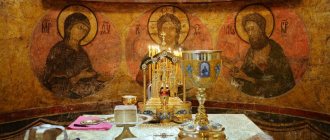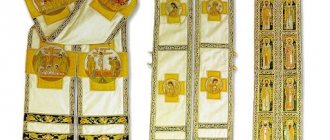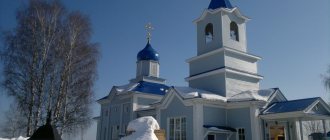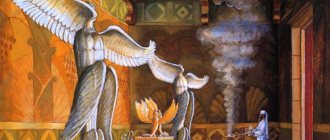Pulpit as a form of architectural art
Translated from Greek, “ambo” means a mountain ledge, climbing to the top.
Simeon of Thessalonica - Archbishop of Thessaloniki in the 15th century. He wrote that the pulpit in the temple is the stone of the Holy Sepulcher, from which priests and deacons, like angels, bring good news to the people in the temple. (Source: Chapter 18 of the Book of the Temple)
“Books about the Temple” by St. Simeon of Thessalonica
Pulpits were first mentioned in the canons of the Council of Laodicea in 364. There is little information about them. In rich churches - for example, Hagia Sophia, they were huge. Sometimes pulpits were carved from a single piece of marble. The oldest example of this type is the Solunsky sample, which now exists in the form of two large pieces of marble. If you put them together, it will be more than 5 meters. It had the shape of a semicircular tower.
The pulpit was built of marble and decorated with carvings, gold and sculptural mosaics. It became part of the soleya only in the 17th century.
Pulpit in the Cathedral of Salerno, Italy, 1180
Interior architecture of the temple
Anyone who has ever been to an Orthodox church has noticed the extraordinary, unearthly atmosphere reigning there. This effect is achieved by building the temple in accordance with the records in the tradition, which originates from the laws of the Old Testament. The first temple was created even before the coming of the Savior. In those days, the Jews were nomads and livestock farmers, so their temple was located in a tent and was portable. The canons of the interior decoration of the tabernacle were given to Moses by the Lord himself on Mount Sinai.
This is how Josephus Flavius describes the first temple:
“The interior of the tabernacle was divided lengthwise into three parts. This three-part division of the tabernacle represented in some way the view of the whole world: for the third part, located between the four pillars and inaccessible to the priests themselves, meant in some way Heaven, dedicated to God; a space of twenty cubits, as if representing the earth and sea, over which people have a free path, was determined for the priests alone” (Antiquities of the Jews, book III, chapter 6)
Solea - the place where the pulpit is located
Solea is a semicircular platform in front of the altar floor. It is raised above the main level of the church. On the sides of the solea, on the choirs, there are singers or readers. In some churches there is no choir on the sole.
Scheme of the altar part of the temple. Please note that the soleya occupies the entire width of the temple.
The practical meaning of the sole is a convenient elevation to bear the Holy Scriptures. The minister takes the Gospel from the Throne, carries it out along the salt, and returns it to its place through the Royal Doors.
Ritual sacrifices
The main place of the church, which has survived to this day, was the altar - the altar. Before the coming of Christ, ritual killings of animals were practiced. Typically, livestock farmers sacrificed a lamb, and farmers placed the fruits of their labors on the altar: vegetables, grains and fruits. Animal sacrifice was necessary in those days so that people would not exterminate each other; God did not need the blood of an innocent animal, but seeing the aggressive nature of the Old Testament people, He established the law of sacrifices. The final sacrifice, the Lamb crucified on the cross, was the Son of God. Since then, the New Testament began, and the sacrifice at the liturgy became bloodless.
Detailed recommendations for the construction of the temple are found in texts from the beginning of the fourth century. The details reveal the works of the holy fathers from the fourth to eighth centuries AD. What the pulpit is and what it looks like is well described in their works by Maxim the Confessor, Andrew of Crete, and John of Damascus. And other revered righteous people.
The church pulpit (photo below) shows a priest standing on it; behind him, in the open Royal Doors, you can see the altar - the altar.
Greek pulpit in Rus'
In Rus', pulpits were most often built according to Byzantine drawings from the 12th century. Such an ancient Russian pulpit of the St. Sophia Cathedral in Novgorod has been preserved.
General view of the pulpit of 1533 from the Hagia Sophia Cathedral (Sophia Cathedral) of Veliky Novgorod before restoration. Height - 300 cm, circumference - 600 cm
Now it is the only surviving free-standing wooden pulpit of the Byzantine Orthodox tradition in the world.
It looked like a round gazebo with one entrance. It was supported by a column arch, almost human height. It was decorated with flowers and patterns.
The pulpit was built of wood and performed many functions - the most important hymns were sung there, the sacred texts of the Gospel and the Apostle were read.
The sacred rite “Elevation of the Cross” was performed there. The structure has survived to this day, but now you can only see it in the State Museum of St. Petersburg.
The pulpit of the St. Sophia Cathedral is being restored at the Russian Museum in 2014
Pulpit - the outermost projection of the pre-altar elevation in an ancient Christian church, from which the texts of the Bible, sermons were read, psalms were sung and liturgical actions were performed. Judging by the few surviving monuments and descriptions, it was a semicircular tower carved from marble, to the upper platform of which two staircases (“shoots”) led. The front side of the pulpit was decorated with sculptural images. In ancient churches of the basilica form, the pulpit was placed in the middle of the temple (if there was one) or on the right and left sides of the nave, if there were two (in some churches, one pulpit was intended for reading the Apostle, the other for reading the Gospel). On the upper platform of the pulpit there was a music stand for books, a candlestick and a seat for the bishop. The prototype for ancient Russian pulpits, in particular, for the wooden pulpit of the St. Sophia Cathedral in Novgorod, built in 1533 under Archbishop Macarius and arousing the admiration of his contemporaries, could be the pulpit of St. Sophia of Constantinople, which was surrounded by 8 columns, and above them rose a roof (ciborium ). This is the only surviving ancient Russian pulpit of this type (currently located in the Russian Museum). From this pulpit the Apostle and the Gospel were read, the most important hymns were sung, and the synod was proclaimed. The ritual “Elevation of the Cross” was also performed on it during the holiday of the same name, and a special role was given to the Novgorod pulpit during the action “Walking on a Donkey.” Obviously, the pulpit in ancient Russian worship served as an image of the Heavenly Jerusalem, the ideal City and Temple, in which “sublime” (in the spiritual and even literal sense) service takes place. After the 17th century such pulpits are disappearing. In the Russian Orthodox Church, the pulpit is a semicircular part of the solea opposite the royal doors (the solea is the elevation in front of the iconostasis). Symbolically, the pulpit is the stone with which the entrance to the burial cave of Jesus was blocked and which was moved aside by an angel (in the Gospel of Luke - two angels) on the day of the Resurrection. The priest and deacon who rose to the pulpit symbolize the angels - the messengers of the Resurrection of the Lord. Therefore, non-clergymen were strictly forbidden to ascend to the pulpit. Currently, there are two types of pulpits - 1. “Pre-altar pulpit” - a semicircular platform, which is like a continuation of the central part of the solea (opposite the Royal Doors), with its protrusion facing the worshipers, from where the deacon pronounces litanies and reads the Gospel, the priest preaches, teaches Prayers receive communion and a cross at the end of the service. – 2. “Bishop pulpit” - a square elevation in the middle part of the church (usually portable), on which the bishop vests and stands surrounded by clergy and believers up to the Small Entrance while he celebrates the Liturgy. Hence another name in liturgical books - “cloud place”. Typically, it has two steps that mark Jacob's ladder. Nowadays, free-standing low pulpits in the Russian Orthodox Church are found in cathedrals and are used only as a “cloud place”.
The purpose of the pulpit in the temple is a place for reading the Bible and the Apostle
The deacons stand on the pulpit and read the books of the Old and New Testaments. Why is the pulpit located in this particular place - on a hill, near the central dome?
The fact is that this place has good acoustics.
Basilica of St. Clement and Lawrence in Italy. It is interesting because there are two pulpits - on the right side and on the left. One of them is used for reading the Gospel, the other for reading the Apostle
Sometimes two pulpits were combined into one two-story pulpit. One such example is in the Church of St. Stamp in Venice.
They look like a large and a small gazebo. Sometimes large candlesticks are added to the pulpit, in the form of twisted columns and latticework for fencing.
St. Mark's Cathedral, 14th century. Two-tier pulpit
Resurrection of Christ
On the third day after the crucifixion of the Savior, the myrrh-bearing wives found the stone covering the entrance to the tomb rolled away. An angel sat on the stone and told the frightened women about the Resurrection of Christ. From that moment on, all believers became involved in His immortality. Sacrifice made salvation possible. Since then, the Body and Blood of Christ has been served to parishioners from the pulpit.
What is the Eucharist: by receiving communion and confessing, following the example of the disciples at the Last Supper before the arrest of the Savior, Orthodox Christians receive remission of sins and the opportunity to enter after death into a better world, the Kingdom of Heaven. It was this stone that became the prototype of the pulpit. The priest, like an angel at the tomb, announces to the flock the good news of human salvation.
Bishop's pulpit
In the first churches, in the middle part of the temple there was a bishop's pulpit. Another name is locker. It symbolized the mountain from which Jesus Christ spoke his Sermon on the Mount. Now the bishop's pulpit may stand a little further south.
Sometimes it was called the “place of clouds”—the bishop dressed there. Another name is “prepared place.” He was elevated according to the status of a priest, mainly by two levels. But when they consecrate bishops, the locker is raised from 4 to 6 steps. At this unique pulpit, funeral services, prayer services, and royal hours ended.
Bishop's pulpit in the St. Nicholas Convent. It differs from a regular pulpit in that it has a pulpit.
Church is a ship
An Orthodox church is a thoughtful, symbolic structure. The Church personifies the “ship of salvation”, which, like the ark of righteous Noah, will deliver its passengers from the stormy ocean of the modern world. The interior decoration of the temple, architecture and interior details are arranged in strict accordance with Orthodox tradition. This is why the house of the Lord is not like other earthly buildings.
Catholic Church
The pulpits of Western churches initially did not differ from Byzantine ones. Since the 11th century, double pulpits have appeared here (an interesting example of such a pulpit has been preserved in the Church of St. Clement in Rome), located on the sides of the naos: on the south side - for reading and explaining the Gospel, on the north - for reading Acts and Epistles. Stairs led to the heights.
These pulpits soon began to play an important role in the decoration of churches; they were decorated luxuriously, first with mosaics and later with carvings. The growth of congregations displaced these two pulpits, and they merged into the modern pulpit. In Catholic and Protestant churches, pulpits are usually replaced by music stands.
Links
- [www.patriarchia.ru/db/print/35117.html Article “pulp” on the website of the Russian Orthodox Church]. [www.webcitation.org/6CY2pfacq Archived from the original on November 30, 2012].
- [church-enc.info/p1-44.html Bishop's pulpit (article in the Encyclopedia of Orthodoxy)](inaccessible link - history
). [web.archive.org/20080119075150/church-enc.info/p1-44.html Archived from the original on January 19, 2008]. - [sakkos.ru/terms-khram/amvon.html Illustrated dictionary of church Orthodox terms - internal structure and decoration of the temple]. [www.webcitation.org/6CY2qING1 Archived from the original on November 30, 2012].
Excerpt characterizing the pulpit
Prince Andrei, leaning on the railing, silently looked along the flood glittering from the setting sun. - Well, what do you think about this? - asked Pierre, - why are you silent? - What I think? I listened to you. “It’s all true,” said Prince Andrei. “But you say: join our brotherhood, and we will show you the purpose of life and the purpose of man, and the laws that govern the world.” Who are we, people? Why do you know everything? Why am I the only one who doesn’t see what you see? You see the kingdom of goodness and truth on earth, but I don’t see it. Pierre interrupted him. – Do you believe in a future life? - he asked. - To the future life? – Prince Andrei repeated, but Pierre did not give him time to answer and took this repetition as a denial, especially since he knew Prince Andrei’s previous atheistic beliefs. – You say that you cannot see the kingdom of goodness and truth on earth. And I have not seen him and he cannot be seen if we look at our life as the end of everything. On earth, precisely on this earth (Pierre pointed in the field), there is no truth - everything is lies and evil; but in the world, in the whole world, there is a kingdom of truth, and we are now children of the earth, and forever children of the whole world. Don't I feel in my soul that I am part of this huge, harmonious whole. Don’t I feel that I am in this huge countless number of beings in which the Divinity is manifested - the highest power, as you like - that I constitute one link, one step from lower beings to higher ones. If I see, clearly see this staircase that leads from a plant to a person, then why should I assume that this staircase breaks with me, and does not lead further and further. I feel that not only can I not disappear, just as nothing disappears in the world, but that I will always be and always have been. I feel that besides me there are spirits living above me and that there is truth in this world. “Yes, this is Herder’s teaching,” said Prince Andrei, “but that, my soul, is not what convinces me, but life and death, that’s what convinces me.” What is convincing is that you see a being dear to you, who is connected with you, before whom you were guilty and hoped to justify yourself (Prince Andrei’s voice trembled and turned away) and suddenly this being suffers, is tormented and ceases to be... Why? It cannot be that there is no answer! And I believe that he is... That’s what convinces, that’s what convinced me,” said Prince Andrei. “Well, yes, well,” said Pierre, “isn’t that what I’m saying!” - No. I’m only saying that it’s not arguments that convince you of the need for a future life, but when you walk in life hand in hand with a person, and suddenly this person disappears out there into nowhere, and you yourself stop in front of this abyss and look into it. And, I looked in... - Well, then! do you know what is there and that there is someone? There is a future life there. Someone is God. Prince Andrei did not answer. The carriage and horses had long been taken to the other side and had already been laid down, and the sun had already disappeared halfway, and the evening frost covered the puddles near the ferry with stars, and Pierre and Andrey, to the surprise of the footmen, coachmen and carriers, were still standing on the ferry and talking. – If there is God and there is a future life, then there is truth, there is virtue; and man's highest happiness consists in striving to achieve them. We must live, we must love, we must believe, said Pierre, that we do not live now only on this piece of land, but have lived and will live forever there in everything (he pointed to the sky). Prince Andrey stood with his elbows on the railing of the ferry and, listening to Pierre, without taking his eyes off, looked at the red reflection of the sun on the blue flood. Pierre fell silent. It was completely silent. The ferry had landed long ago, and only the waves of the current hit the bottom of the ferry with a faint sound. It seemed to Prince Andrei that this rinsing of the waves was saying to Pierre’s words: “true, believe it.” Prince Andrei sighed and with a radiant, childish, tender gaze looked into Pierre’s flushed, enthusiastic, but increasingly timid face in front of his superior friend.
Literature
- Pulpit, ambo // Vlasov V. G. New encyclopedic dictionary of fine arts. In 10 volumes. T. I. - St. Petersburg: Azbuka-classics, 2004. - P. 216.
- Petrovsky A.V., Markov N.F.
Ambon // Orthodox Theological Encyclopedia. - St. Petersburg: Petrograd Publishing House. Supplement to the spiritual magazine “Wanderer”, 1900. - T. 1. - Stb. 576 - Trapeznikov A.
Temple, Rituals, Worship. - M.: Veche, 2007. - Ulyanov O. G.
Ambon of 1533 in the historical and liturgical context (Cave action or consecration). St. Petersburg: State Russian Museum, 2021. - Pulpit // Encyclopedic Dictionary of Brockhaus and Efron: in 86 volumes (82 volumes and 4 additional). - St. Petersburg, 1890-1907.
Phonetic analysis of the "bishop's pulpit"
Phonetically, the letters E - [ye], E - [yo], Yu - [yu], I - [ya] often denote two sounds at once. Have you noticed that in all the indicated cases the additional phoneme is “Y”? That is why these vowels are called iotized. The meaning of the letters E, E, Yu, I is determined by their positional position.
When analyzed phonetically, the vowels e, e, yu, i form 2 sounds:
◊ Yo - [yo], Yu - [yu], E - [ye], I - [ya] in cases where there are:
- At the beginning of the words “Yo” and “Yu” there are always: - shudder [yo´zhyts:a], Christmas tree [yo´lach'nyy], hedgehog [yo´zhyk], container [yo´mcast'];
- - jeweler [yuv'il'i´r], top [yula´], skirt [yu´pka], Jupiter [yup'i´t'ir], nimbleness [yu´rkas't'];
- - spruce [ye´l'], ride [ye´zh:u], huntsman [ye´g'ir'], eunuch [ye´vnukh];
- - receiver [pr'iyo´mn'ik], sings [payo´t], pecks [kl'uyo´t];
As you can see, in the phonemic system of the Russian language, stress is of decisive importance. Vowels in unstressed syllables undergo the greatest reduction. Let's continue the sound-letter analysis of the remaining iotized ones and see how they can still change characteristics depending on the environment in the words.
◊ Unstressed vowels “E” and “I” denote two sounds in phonetic transcription and are written as [YI]:
- at the very beginning of the word: - unity [yid'in'e´n'i'ye], spruce [yil´vyy], blackberry [yizhiv'i´ka], him [yivo´], fidget [yigaza´], Yenisei [yin'is'e´y], Egypt [yig'i´p'it];
- - January [yinvarskiy], core [yidro´], sting [yiz'v'i´t'], label [yirly´k], Japan [yipo´n'iya], lamb [yign'o´nak] ;
- (The only exceptions are rare foreign word forms and names: Caucasoid [yevrap'io´idnaya], Evgeny [ye]vge´niy, European [yevrap'e´yits], diocese [ye]parchy, etc.).
- in a timely manner [svayivr'e´m'ina], trains [payizda´], let's eat [payid'i´m], run into [nayizh:a´t'], Belgian [b'il'g'i´yits], students [uch'a´sh'iyis'a], proposals [pr'idlazhe´n'iyim'i], vanity [suyita´],
Note: The St. Petersburg phonological school is characterized by “ecane”, and the Moscow school is characterized by “hiccup”. Previously, the iotrated “Yo” was pronounced with a more accented “Ye”. When changing capitals, performing sound-letter analysis, they adhere to Moscow norms in orthoepy.
Some people in fluent speech pronounce the vowel “I” the same way in syllables with a strong and weak position. This pronunciation is considered a dialect and is not literary. Remember, the vowel “I” under stress and without stress is voiced differently: fair [ya´farmarka], but egg [yiytso´].
Important:
The letter “I” after the soft sign “b” also represents 2 sounds - [YI] in sound-letter analysis. (This rule is relevant for syllables in both strong and weak positions). Let's conduct a sample of online sound-letter analysis: - nightingales [salav'yi'], on chicken legs [on ku´r'yi'h' no´shkah], rabbit [kro´l'ich'yi], no family [s'im 'yi´], judges [su´d'yi], draws [n'ich'yi´], streams [ruch'yi´], foxes [li´s'yi]. But: The vowel “O” after the soft sign “b” is transcribed as an apostrophe of softness ['] of the preceding consonant and [O], although when pronouncing the phoneme, iotization can be heard: broth [bul'on'n], pavilion [pav'il'o ´н], similar: postman, champignon, chignon, companion, medallion, battalion, guillotine, carmagnola, minion and others.
Phonetic analysis of words, when the vowels “Yu” “E” “E” “I” form 1 sound
According to the rules of phonetics of the Russian language, at a certain position in words, the designated letters give one sound when:
- sound units “Yo” “Yu” “E” are under stress after an unpaired consonant in hardness: zh, sh, ts. Then they designate phonemes: ё - [o],
- e - [e],
- yu - [y].
Examples of online analysis by sounds: yellow [zho´lty], silk [sho´lk], whole [tse´ly], recipe [r'itse´pt], pearls [zhe´mch'uk], six [she´st '], hornet [she´rshen'], parachute [parashu´t];
- ё – [o]: ticket [put'o´fka], easy [l'o´khk'iy], honey fungus [ap'o´nak], actor [akt'o´r], child [r'ib' o´nak];











